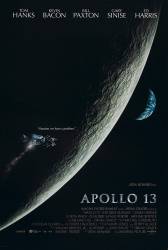Factual error: Technician John Aaron states that the damaged ship will need to use "less amps than this" as he points to a vintage 'Mr. Coffee' coffee-maker on his desk. Mr. Coffee was not introduced until 1972.

Apollo 13 (1995)
Plot summary
Directed by: Ron Howard
Starring: Tom Hanks, Ed Harris, Kevin Bacon, Bill Paxton, Gary Sinise
A trip to the moon is planned but the ship malfunctions halfway.
Fred Haise: It hurts when I urinate.
Jim Lovell: Well, you're not getting enough water.
Fred Haise: No, I'm drinkin' my rations, same as you... I think old Swigert gave me the clap. Been pissin' in my relief tube.
Jim Lovell: Well, that'd be a hot one at the debriefing for the flight surgeons... Another first for America's spacemen.
Trivia: The Apollo 13 mission set a record for the greatest distance from Earth ever achieved by mankind. This occurred because unlike the other Apollos, Apollo 13 did not make a burn behind the moon to drop into lunar orbit. The free-return trajectory the mission followed took the spacecraft farther behind the moon than any other mission.
Join the mailing list
Separate from membership, this is to get updates about mistakes in recent releases. Addresses are not passed on to any third party, and are used solely for direct communication from this site. You can unsubscribe at any time.
Check out the mistake & trivia books, on Kindle and in paperback.




Answer: Spacecraft re-enter Earth's atmosphere at extremely high velocity (thousands of miles per hour). Atmospheric friction slows the spacecraft descent somewhat; but, without parachutes, the Apollo spacecraft would still reach the surface traveling at hundreds of miles per hour. Landing in water at such high speed would be like hitting concrete, which would of course be instantly fatal. Hence the necessity of multiple parachutes. The Apollo program (and all early U.S. manned space programs) chose to land in the ocean for two reasons: 1) It was easier to track spacecraft re-entry from horizon-to-horizon at sea without visual and radar obstacles, and; 2) It was faster and easier to position several Navy vessels in the general splashdown location, then deploy helicopters to rapidly retrieve the astronauts and their spacecraft.
Charles Austin Miller